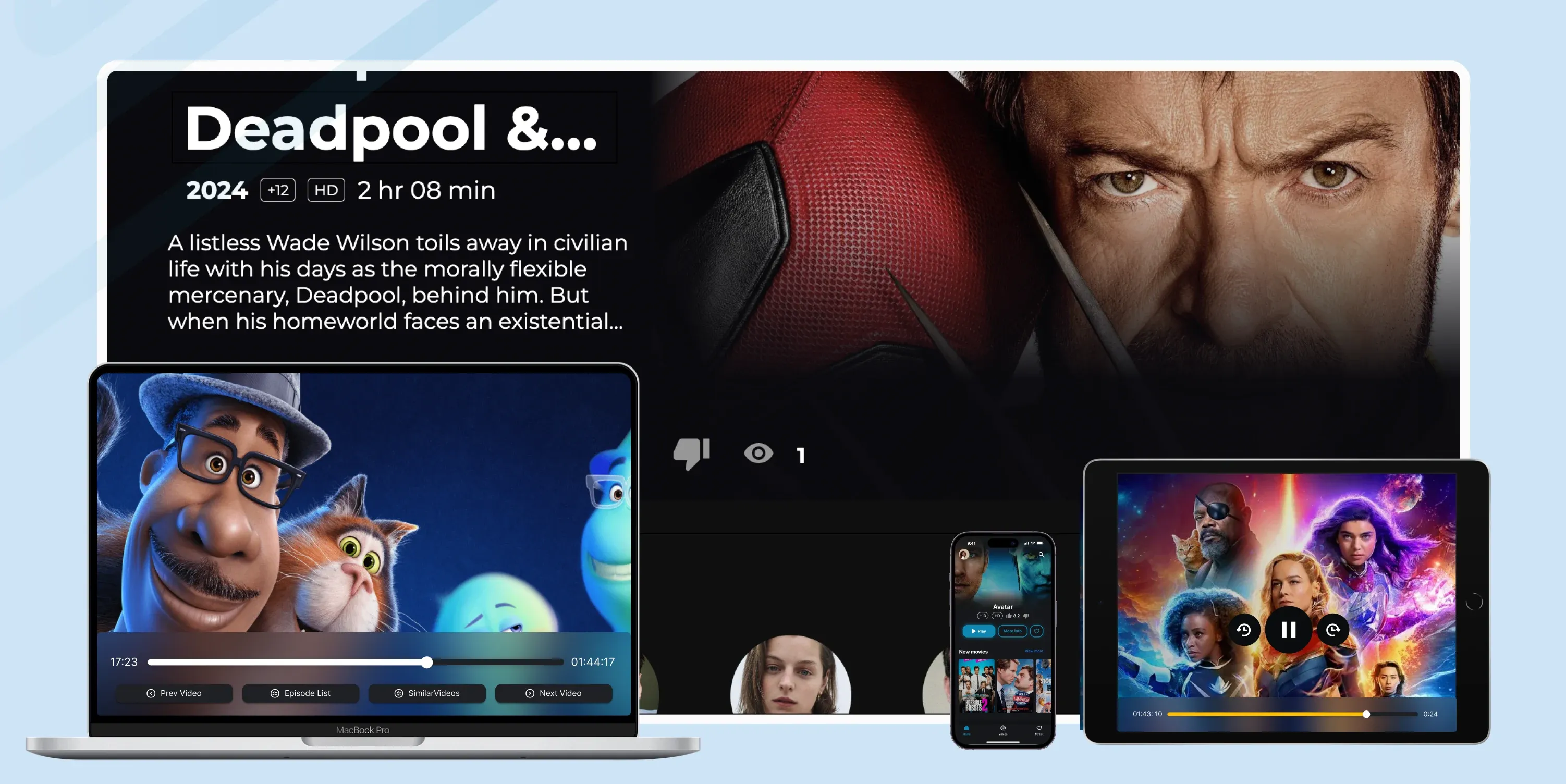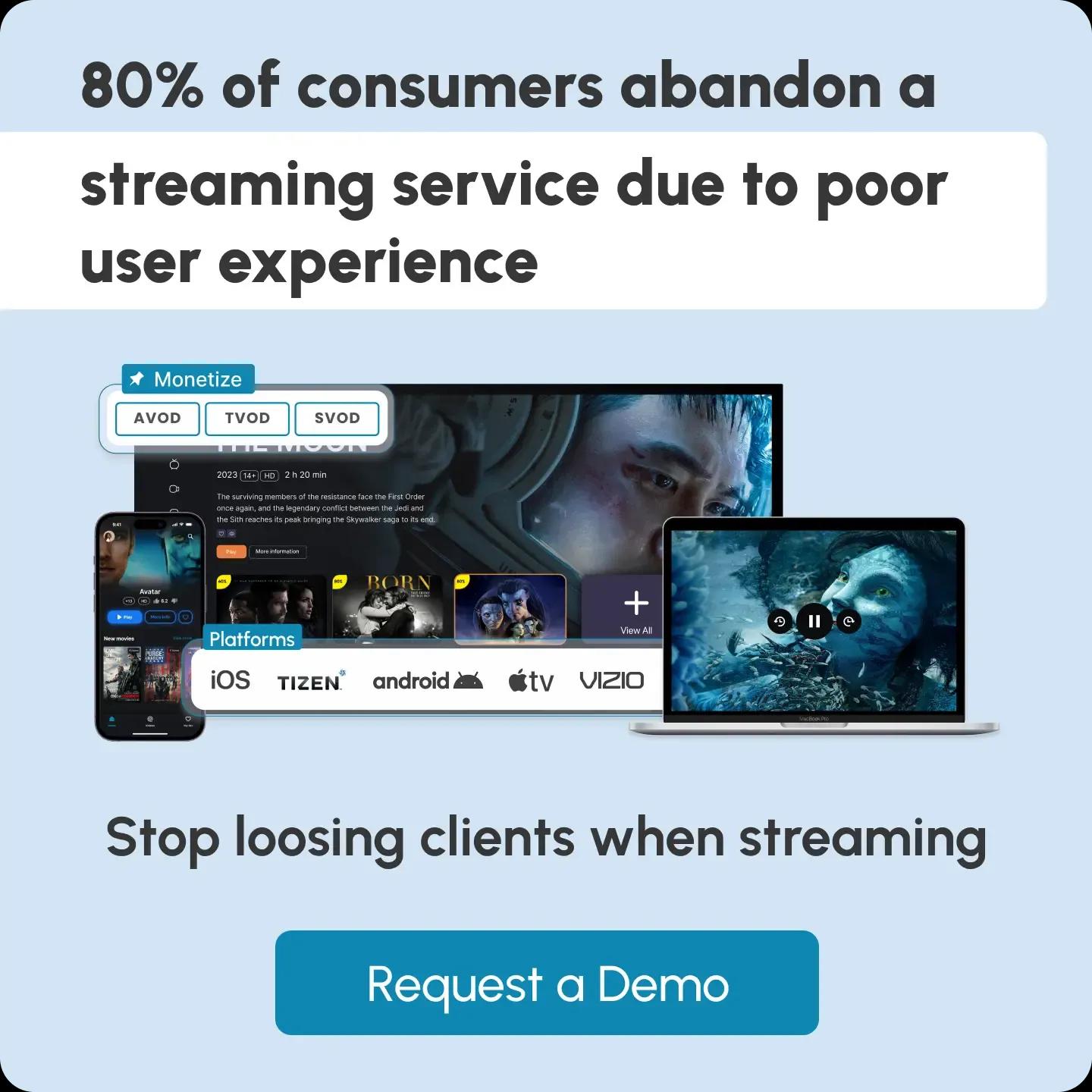
How to Start a Streaming Service: A Comprehensive Guide
What if we tell you there is a possibility you can build your very own streaming service that can grow to be just as successful as Netflix? You wouldn’t believe it, but it is realistic.
Regardless of your business, learning how to create a streaming service could be your next ticket to success.
If you’re interested, this article provides a detailed tutorial on setting up a streaming service, from the idea to implementation. Read on to create your successful video streaming service.

Let's start with the main steps to consider when starting a streaming service
Step 1. Understanding the Streaming Service Market
From binge-watching the latest shows to tuning into live events, the market for digital video is growing fast.
The global video streaming market is set to expand by around 8.27% from 2024 to 2027. Experts predict the market’s worth could grow to about $137.7 billion. What about OTT market, in 2024, the global OTT(over-the-top) video revenue reached over 316 billion U.S. dollars, with the United States accounting for the largest share of that sum.
This growth is driven by changing consumer habits, improved internet access, and the popularity of mobile devices. These are the main things you should consider when starting a streaming service.
Streaming services compete to stand out in a crowded market. As a result, they’re offering original content and further improving the viewing experience to keep customers engaged.
So, your focus should be on creating original content for your target audience to stay relevant and wanted.
Step 2. Identifying Your Niche
Think about specific niches when you set up a streaming service. Select content relating to a given topic, like food, sports, or fitness.
For a better understanding, here is a table categorizing niche audiences:
| Niche Audience | Content Preference | Example Platforms |
|---|---|---|
| Horror and Thriller Fans | Horror, thriller, supernatural fiction | Shudder |
| Sports Enthusiasts | Live sports, major events, sports documentaries | DAZN, ESPN+, Paramount+, Sling TV |
| Music Lovers | Music streaming, different genres, emerging artists | Apple Music, Spotify, SoundCloud, Mixcloud |
| Anime Fans | Anime series, films, classic and modern titles | Crunchyroll, HIDIVE, RetroCrush |
| Parents and Families | Family-friendly content, parental controls | Disney+, PBS Kids, Netflix Kids |
| Fitness Enthusiasts | Workout videos, yoga, training programs, wellness content | Peloton, Apple Fitness+, Beachbody On Demand |
| Food and Cooking Fans | Cooking shows, recipe videos, culinary documentaries | Food Network Kitchen, Tastemade, Bon Appétit |
| Documentary Buffs | True crime, history, science, social issues | CuriosityStream, MagellanTV, Netflix Docs |
| Classic Movie Lovers | Vintage films, golden age Hollywood, international cinema | Criterion Channel, TCM, MUBI |
| Niche Gaming Fans | Video game streaming, esports, and game reviews | Twitch, YouTube Gaming, Trovo |
Choosing your niche audience is the main key to success since most of your decision making will revolve around your target audience’s needs and demands.
Step 3. Planning Your Streaming Service
If you want to increase sales, spread awareness of your company, or advertise a specific good or service, you have to be clear about your business goals to create a strategic plan that complements them.
Building a successful streaming service starts with understanding your audience. Take the time to research their preferences, interests, and demographics. This data helps you create content and messages that connect with viewers, boosting engagement and customer loyalty.
A well-crafted strategy can make your streaming platform stand out in a crowded market. The key is finding the right balance between catering to a focused group and expanding your reach.
Budgeting
Streaming giants spend millions on technology, licensing fees, and marketing, but smaller niche services can start with much less, depending on their scope and goals. Factor in costs for cloud storage, bandwidth, and content rights for your budget.
Calculating an approximate budget based on the necessary expenses your startup needs, can save resources like time, money, and more.
Technical Requirements to Consider
Let's explore the technical requirements of setting up a streaming service.
Bandwidth
Bandwidth is crucial for delivering smooth HD live streams. It measures how much data your network can send in a given time. The higher the bandwidth, the better the stream quality and speed.
The optimum HD live video should have at least 5 Mbps of bandwidth. This speed guarantees that the quality of the audio and the video remains constant, ensuring a flawless experience for viewers. The best results come from having a bandwidth of 10 Mbps or higher.
Video Encoding
Encoding is the process of converting raw video into a digital format ready for streaming. It plays an important role in determining video quality.
HD live streaming requires high-quality codecs, like H.264 or H.265. Given its good mix of quality and file size, many consider H.264 the best video codec for live broadcasting.
Conversely, H.265 is a more modern codec with superior quality and compression. It requires additional computing capability, so it may not suit everyone.
Audio Quality
Good sound quality keeps viewers engaged, focused, and avoids frustration during the stream.
The quality for stereo sound should be at least 128 kbps. Apart from the bitrate, your selected audio format greatly influences the sound quality.
AAC (Advanced Audio Coding) is the most-used format for live streaming. It offers high-quality sound with a low bitrate, making it perfect for live broadcasts.
Step 4. Create a Business Plan
A well-defined business plan helps you start a streaming service successfully. Every startup should go through this essential step.
Your streaming service revolves around creating video content. Be clear on the type of media you’ll offer. Does it come from other people, or is it original? Consider which approach fits your vision and audience best.
Legal Registration and Content Licensing
Another crucial component of preparing a streaming service is ensuring the company abides by media laws. Setting up video streaming services requires content licensing and legal registration.
Motion Picture Licensing Corporation (MPLC) and SWANK Motion Pictures stand out among US-based organizations offering video content. These licensing companies help you find solutions for setting up a streaming service.
Step 5. Launching Your Streaming Service
Consider a few aspects before launching your streaming service. Here are a few to get you started
| Aspect | Key Considerations | Details |
|---|---|---|
| User Interface (UI) | Unique design, easy navigation | Avoid copying existing platforms; create a distinct look. |
| Marketing Strategies | Brand awareness, engagement, customer acquisition | Plan how to attract and retain paying members. |
| Marketing Funnel | Consumer journey, tailored strategies | Understand user preferences and guide them from discovery to subscription. |
| SEO Optimization | Keywords, meta tags, backlinks | Boost search engine visibility and drive organic traffic. |
Step 6. Post-Launch Updates
After launching a streaming service, continuous updates and improvements are necessary to retain users, attract new subscribers, and enhance the platform’s performance.
Let’s go through 5 key post-launch updates you can focus on:
1. Content Expansion
- Regular Content Additions – Upload new movies, shows, music, or live events to keep users engaged.
- Exclusive and Original Content – Invest in original series, films, or live broadcasts to differentiate your platform.
- User-Generated Content (UGC) – Allow creators to upload videos (if applicable).
2. Performance and Technical Enhancements
- Optimize Streaming Quality – Improve adaptive bitrate streaming (ABR) to reduce buffering.
- Improve Server and CDN Performance – Scale servers to handle more users and reduce latency.
- App Updates and Bug Fixes – Regularly release app updates to fix technical issues and improve usability.
- Device Compatibility – Expand support for smart TVs, game consoles, and various mobile platforms.
3. User Experience (UX) Improvements
- Better Recommendation Algorithms – Use AI to suggest content based on user preferences.
- Enhanced Search and Filtering – Improve navigation to help users find content easily.
- Personalized Playlists and Watchlists – Let users save and organize their favorite content.
4. Marketing and Growth Strategies
- Loyalty Programs and Discounts – Offer deals to retain long-term subscribers.
- Referral Programs – Encourage users to invite friends by offering rewards.
- Social Media Engagement – Increase interaction through social platforms, ads, and influencer marketing.
5. Security and Compliance
- Enhance DRM (Digital Rights Management) – Prevent unauthorized content access and piracy.
- User Data Protection – Strengthen cybersecurity measures to protect user information.
- Parental Controls – Provide safe viewing options for kids.
Start Your Successful Streaming Service with inoRain
inoRain guarantees a successful start for your streaming service. With our customizable software solutions, you can provide Video-on-Demand (VOD) and Over-the-Top (OTT) services to your end users.
inoRain will support you in delivering secure, high-quality content through monetization models like SVOD, AVOD, and TVOD.
Ready to take your business to the next level? Partner with inoRain today for a streaming solution that brings you long-term success.
Conclusion
Streaming is a promising business opportunity that meets the growing demand for digital content. Projections expect the worldwide video streaming market to grow at a compound annual growth rate (CAGR) of 21.5% from 2024 to 2030. It could reach $416.84 billion by 2030. This fact means massive potential for significant and exponential growth.
Remember to follow each step, from identifying your target audience to developing a solid business model. Ensuring strong technical performance and using effective marketing strategies is essential for your future streaming service’s success.
Frequently Asked Questions
Founder / CEO
Andranik is the CEO and Co-Founder of inoRain OTT and the Co-Founder of HotelSmarters, specializing in next-generation streaming technologies and digital transformation for the hospitality sector. He focuses on building innovative, scalable solutions for video delivery, OTT monetization, and data-driven hospitality management. His work bridges technical sophistication with practical business impact, helping organizations modernize their digital ecosystems and improve operational efficiency.

OTT Advertising: Types, Best Practices, and Strategies
Over-the-top (OTT) advertising has transformed how brands connect with consumers.

VPlayed Alternatives: inoRain vs. VPlayed
Explore inoRain as a VPlayed alternative, comparing features, pricing, and OTT solutions to find the best platform for your streaming needs.

Custom OTT Platform Development: How to Start an OTT Business
This guide will walk you through everything you need to know about the OTT platform development.

